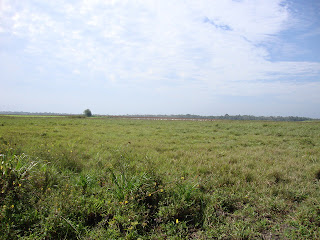The
day began with a gorgeous, vivid sunrise. As I walked down to the
main lodge building to get a cup of tea, I started to mentally
prepare myself for the day. This would be my last full day in the
field working on the Community Wildcat Conservation project.
Unfortunately, the night before I had felt nauseous, feverish, and
sore. By what could only be a work of God, I woke this morning
feeling fine, even free of the back pain I had been experiencing for
days. This was particularly miraculous due to the workload for the
day. Our goal: to check all of our camera stations in Indian Creek
and Eagle Produce. This is the most spread out part of our study area
and involves the most hiking (through acres of Mennonite fields).
Today, the work would not be possible without a vehicle. Lucky for
Matt and I, our director Venetia returned the day before with the
Jeep! Donning new rubber boots, we got an early start on what would
be a long day in the field.
Our
adventure commenced while visiting our first camera site. To set
precedence for the rest of the day, a portion of our route had us
knee deep in water. My new rubber boots afforded little protection
against the ponds of standing water that now dominate the trails
reaching the camera sites. Once each boot is filled with water, only
then is it possible to walk with true abandon through each obstacle.
Progressing
smoothly throughout the day, each camera site was checked and photos
retrieved. Then suddenly we were stuck. Quite literally, stuck… in
mud. The trusty Jeep Wrangler was up to its axles in a very deceiving
substance. The path ahead appeared dry, when in reality it was akin
to quicksand awaiting its next victim. My partner and I were now
stranded in the far reaches of pasture land owned by one of our
project participants, a Mennonite. After fruitlessly trying to free
the Jeep, we used our Nokia phone to call for assistance. This was
little help, as the one person that answered their phone was unable
to come to our aid. There was little choice, we had to walk to find
help. In the meantime, there was also a camera station that needed to
be checked about 1000 km away. It was time to split up. I headed back
toward the jungle's edge to retrieve the photos from the camera site
and Matt headed toward Indian Creek to find help. I returned to a
still stuck Jeep with newly socked socks, and waited. Perched atop
the muddied vehicle I listened to my surroundings. A low rumble
became audible in the distance, and I instantly knew it was a rescue.
Flying toward the Jeep, at speeds I didn't know tractors could even
reach, appeared my partner and our landowner Ben! It was comical how
the tractor pulled our Jeep out of the mud, as if it were a toy car.
With a
new sense of freedom, we continued on to finish the last two camera
stations in Indian Creek. All that remained were two camera stations
at the papaya plantation, Eagle Produce. It's about 4:30 in the
afternoon when we reach the plantation, this allowed us just enough
daylight to finish our work. We saved the best for last! The second
camera station at Eagle Produce was flooded two weeks ago. Although
it's only been somewhat rainy the last few days standing water drains
very slowly from this clay filled landscape. The drive to the camera
station was cut short by large ponds of water in the “road.”
Continuing on foot was the only option. Carrying my trusty rake, I
stepped into the water. As I walked, the water rose. With the rake
held steadily above my head and the water level at my ribs I forged
on. By this time, the sun is setting, and it's the most beautiful
sunset I've seen in Belize. Sadly, without a camera, this moment was
not documented, but will live on forever in my memories. We hurriedly
completed our checklists at the camera site, which was partially
flooded and almost completely dark. The return hike to the Jeep was
the same as before, with one exception. Now lacking a sunset, our
path was only visible by flashes of lightening. Just as the rain
began we made it back to our vehicle to return for a late dinner at
the lodge.
One
epic day, and all I have to show for it is one picture of the
sunrise. I had three blisters on my feet, countless mosquito bites,
and wet clothes. I cannot imagine a better way to end my fieldwork in
Belize.
















